1) Industry structure
2) The two giants
2. Strategies and Critical Success Factors in the Industry
1) There was no specific business-level strategies
2) What happened to Pepsi in 1975 to 1980?
3) The best way to achieve higher market share is good at advertising and marketing campaign.
3. General Environment analysis
4. Strategic Groups within the CSD Industry
5. Industry Opportunities and Threats analysis
6. Description of the Firm
7. Strengths, Weaknesses, Opportunities and Threats
8. Current Strategy
1) Corporate-level Strategy
2) Business-level Strategy
9. Recommended Actions
* Strategic group
All kinds of soft drinks fit in to strategic group. They have similar prices, similar positions and targeting. Especially Coca-cola and Pepsi-cola are the rivals, they compete with each other, in strategic group.
5. Industry Opportunities and Threats analysis
* Opportunities
- Cultivating international markets
By expanding their market to the global markets. They overcame their decreasing CSD sales in US.
Exhibit 10 CSD Industry: Selected International Consumption Rates and Market Shares, 2003 and 1999
At this moment, in US CSD sales were decreasing, but in other countries like Europe and Asia, CSD sales were increasing.
-Fast foods & Restaurants
Distribution of CSD industry in US, the supermarket takes a most of the place and fountain outlets and lastly vending machine. When these industries became active CSD industry gets profit together.
-Well being trend, were the threat for CSD industry
People started to feel that the CSD is bad for health. They start to buy non – carbonated beverages like juices, sports drink, or water.
Exhibit 7 Non-Alcoholic Refreshment Beverage Megabrandsa, 2004 and 2000
But this threat became another opportunities for CSD industry. They released the new concept of cola like “Diet Coke” and other energy drinks like Gatorade, PowerAde for new diet market. This strategy makes CSD industry growing up again.
I anticipate that in the future, there will be no new entrance for CSD industry & The “Coke”, or “Pepsi” will share the profit. In long term consumers behave of taking care of their health, growths of their level of income will decrease the consumption leave of CSD industry.
The criticism of bad substance in CSD makes a CSD market gets small. It will bring about the competition between the companies more intense, with a result of low profit.
6. Description of the Firm
- Company history
Coke: The first Coca-Cola recipe was invented in a drugstore in Columbus, Georgia by John Pemberton, originally as a cocawine called Pemberton's French Wine Coca in 1885. He may have been inspired by the formidable success of Vin Mariani, a European cocawine. In 1886, when Atlanta and Fulton County passed prohibition legislation, Pemberton responded by developing Coca-Cola, essentially a non-alcoholic version of French Wine Cola. The first sales were at Jacob's Pharmacy in Atlanta, Georgia, on May 8, 1886.
Pepsi: It was first introduced as "Brad's Drink"in New Bern,North Carolina in 1898 by Caleb Bradham, who made it at his pharmacy where the drink was sold. It was later named Pepsi Cola, possibly due to the digestive enzyme pepsin and kola nuts used in the recipe. Bradham sought to create a fountain drink that was delicious and would aid in digestion and boost energy. In 1903, Bradham moved the bottling of Pepsi-Cola from his drugstore to a rented warehouse.
- Product lines
Coke: : With a portfolio of more than 3,000 beverages, from diet and regular sparkling beverages to still beverages such as 100 percent fruit juices and fruit drinks, waters, sports and energy drinks, teas and coffees, and milk-and soy-based beverages, our variety spans the globe.
Pepsi: Pepsi has strong Original Cola products. Most of products are familiar to Us but Pepsi Jazz Cola series aren't familiar to Korean customers.
- The scope of the firm
Coke: 3 countries in North America, 18 countries in Latin America, 34 countries in Erope, 30 countries in Eurasia, 40 countries in Africa and 11 countries in Asia.
Pepsi: 2 countries in North America, 24 countries in Latin America, 26 countries in Erope, 9 countries in Middle East, 3 countries in Africa and 11 countries in Asia.
- The size of the firm
Coke: Unit case volume : 23.7 billions bottles, Net operating revenues : $ 31,944 millions, Operating income : 8,446 millions, Net income : $ 5,807 millions
Pepsi: Total net revenue : 43,251 millions , Core net income: 5,887 millions, Core earnings per share: 3.68 millions
- The firm's culture and philosophies
Coke: Missions are to make good situation enough though body, heart and mind. Make different and value-able in everywhere.
Visions are called '5P'. Such as people, planet, portfolio, partners, profit.
Pepsi; Mission is PepsiCo's responsibility is to continually improve all aspects of the world in which we operate (environment, economic, social) creating a better tomorrow than today.
Visions are Care for customers, consumers and the world we live in, sell only products we can be proud of, speak with truth and candor, balance short term and long term, win with diversity and inclusion, respect others and succeed together.
7. Strengths, Weaknesses, Opportunities and Threats



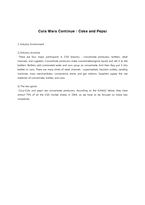
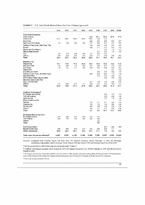
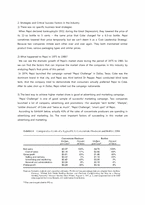
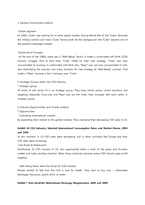
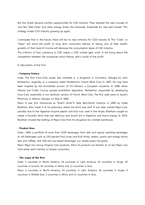

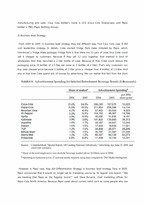

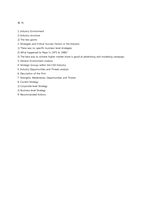
 분야
분야


